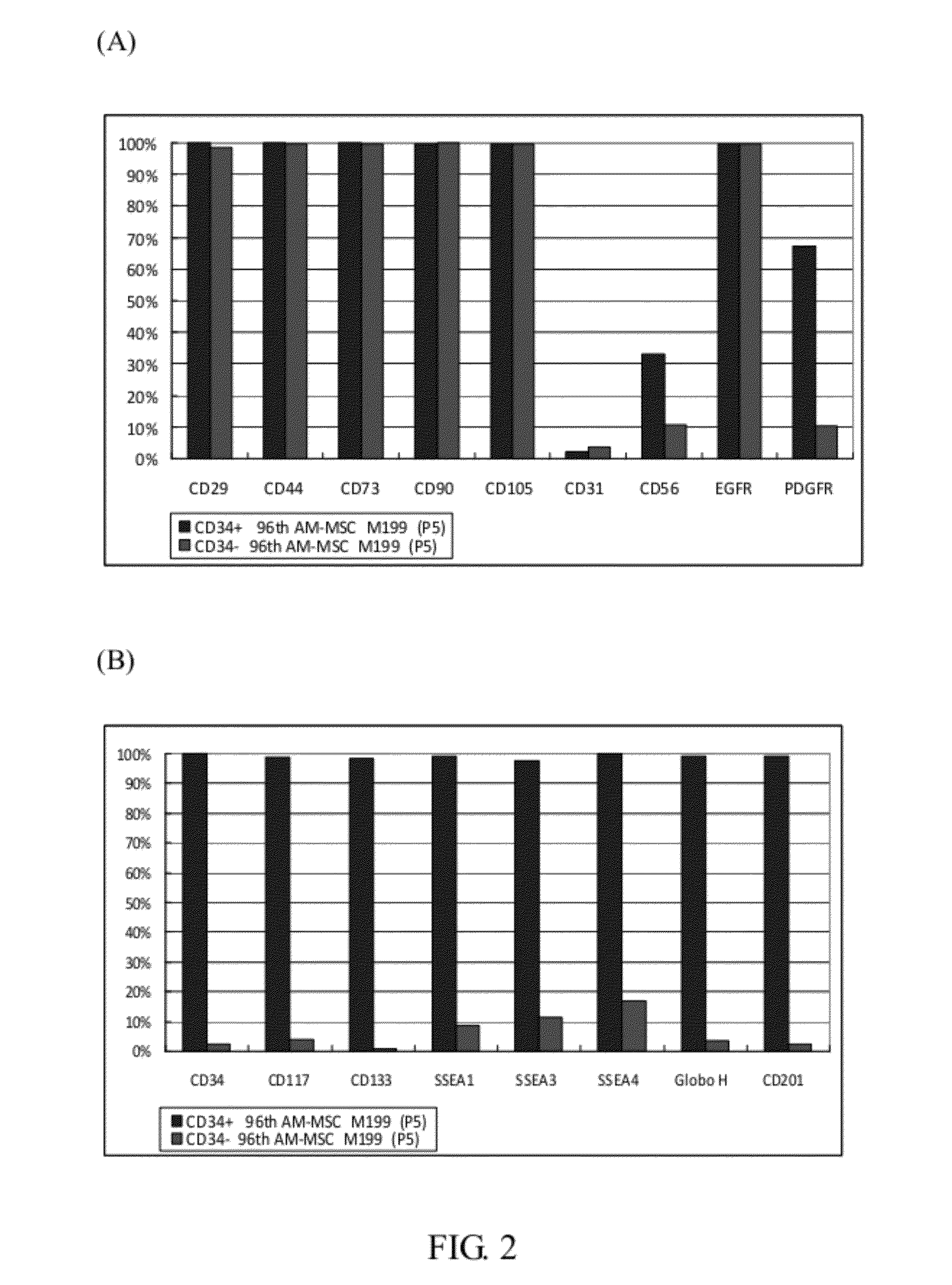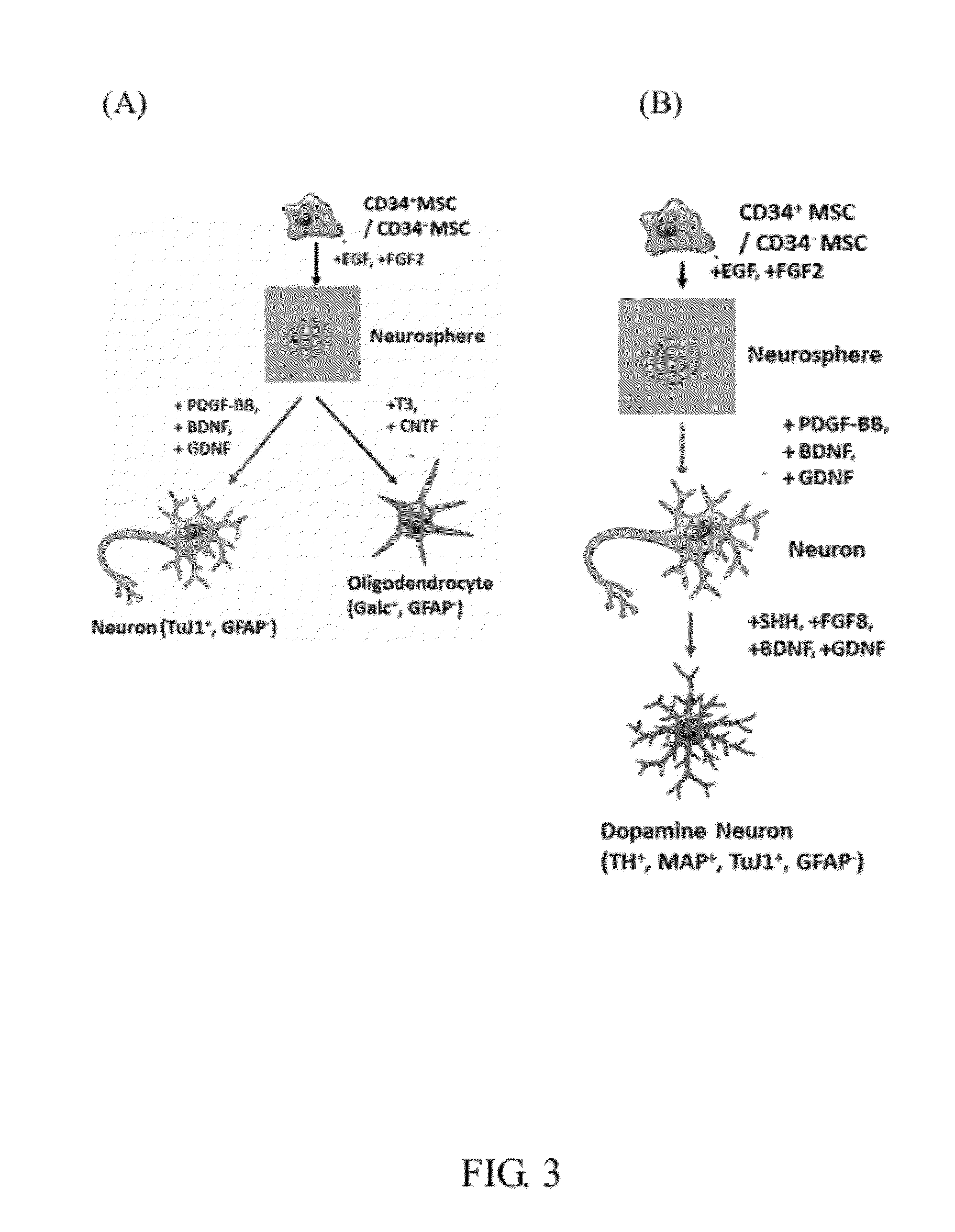Human multipotent embryonic stem cell-like progenitor cells
a multi-potent, embryonic stem cell technology, applied in the field of human multi-potent embryonic stem celllike progenitor cells, can solve the problems of inefficient way and limited differentiation potential of progenitor cells
- Summary
- Abstract
- Description
- Claims
- Application Information
AI Technical Summary
Benefits of technology
Problems solved by technology
Method used
Image
Examples
example 1
Preparation and Characterization of AM-MSCs-CD34+ Cells
[0047]Amnionic Mesenchymal Cell Isolation
[0048](1) Isolation of Amnion Membrane:
[0049]Amnion membrane (about 300 cm2, n=9) was stripped from chorion, washed in 3×150 ml changes of 1× Hank's buffer to remove blood.
[0050](2) Removal of the Amnionic Epithelial Cells:
[0051]To deplete the amnionic epithelial cells (Am-EpCs), washed amnion membrane was cut into 2-3 cm2 fragments and incubated in 100 ml of 0.1% Trypsin-EDTA (Sigma; St Louis, Mo.) with 1× Hanks balanced salt solution (Gibco; CAT#14185-052; Grand Island, N.Y.) for an about 250 cm2 membrane, with 4 times of each 15 min reactions in water bath, at 37° C.
[0052](3) Collection of Clonogenic Amnionic Mesenchymal Stromal Cells (AM-MSCs):
[0053]For the amnionic mesenchymal cells (AM-MSCs) isolation, the Am-EpCs depleted amnion membrane was subjected to wash with Hank's buffer one time and digested with collagenase 1A at 37° C. for 45-60 minutes. An appropriate volume of Hank's bu...
example 2
Induction of Differentiation
[0062](1) Vasculogenic Differentiation
[0063]The AM-MSCs-CD34+ cells at the number of 2×105 at passage 5 were used for the vasculogenic differentiation induction. Harvested cells were cultured in EGM-2 medium (Cambrex) for a 7 days induction. Analysis of the capillary formation was performed using Matrigel (BD Biosciences). Specifically, after the induction culture, the AM-MSCs-CD34+ were trypsinized and plated onto Matrigel coated (Matrigel: M199=1:1) 24 well cluster, with a cell density of 105 cells per well. Capillary-like structures were observed by optical microscopy after 2, 4, 24, and 48 hours in the following 3 days.
[0064](2) Cardiomyogenic Differentiation
[0065]Sorted AM-MSCs-CD34+ cells at passages 4-6 were harvested for induction of cardiomyogenic differentiation. The AM-MSCs-CD34+ cells were incubated overnight in the growth medium [EGM-2:M199 (v:v=1:3) supplemented with 10% FBS, and MEM nonessential amino acids (1×) (GIBCO)]. On the next mornin...
example 3
EnMSCs-CD34+ cells, GMSCs-CD34+ cells, and CD34+ MSCs Enriched from Other Somatic Tissues
[0077]Primary endometrial and gingival tissues were collected from donors from Taipei medical hospital and Dr. Wells Dental clinic follows the IRB guide line. EnMSCs and GMSCs were obtained from endometrial and gingival tissues, respectively, by similar process set forth in Example 1. EnMSCs and GMSCs were then subject to CD34 sorting.
[0078]Phase contrast images of CD34 sorted human endometrium derived mesenchymal stem cells (P5) are given in FIG. 5. The morphology of EnMSCs-CD34+ cells was very similar to AM-MSCs-CD34+. Further, as provided in Table 3 below, AM-MSCs-CD34+ cells, EnMSCs-CD34+ cells, and GMSCs-CD34+ cells were identified as having consistent profiling of cell surface marker expression. Specifically, the mesenchymal common progenitor cells (MCPCs) of the invention were CD14+, CD34+, Nestin+, CD117+, CD133+ (AC133+), SSEA3+, and SSEA4+. Further, the MCPCs of the invention were also...
PUM
| Property | Measurement | Unit |
|---|---|---|
| doubling time | aaaaa | aaaaa |
| doubling time | aaaaa | aaaaa |
| fluorescence | aaaaa | aaaaa |
Abstract
Description
Claims
Application Information
 Login to View More
Login to View More - R&D
- Intellectual Property
- Life Sciences
- Materials
- Tech Scout
- Unparalleled Data Quality
- Higher Quality Content
- 60% Fewer Hallucinations
Browse by: Latest US Patents, China's latest patents, Technical Efficacy Thesaurus, Application Domain, Technology Topic, Popular Technical Reports.
© 2025 PatSnap. All rights reserved.Legal|Privacy policy|Modern Slavery Act Transparency Statement|Sitemap|About US| Contact US: help@patsnap.com



